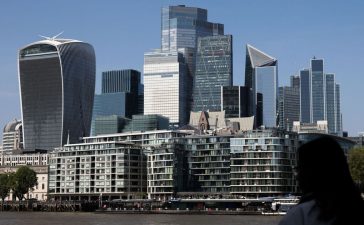When The Telegraph is formally put up for sale this month, bidders keen on acquiring one of the UK media’s most influential rightwing titles will gain access to detailed information on its accounts.
Potential buyers are eagerly awaiting the opening of a data room when, four months after seizing control of the newspaper group along with the Spectator magazine, Lloyds Banking Group fires the starting gun on the sale process.
While the Telegraph’s value goes beyond its ability to turn a profit, interested parties will use its financial records — which those close to the bank have described as “complicated” after decades of ownership by the Barclay family — as a basis for their offers.
Comparisons with rival titles and recent sales will be the first stop in finding the starting point for the auction.
The most recent UK newspaper deal was this summer’s acquisition of lossmaking City AM, which has a print circulation of 250,000 a week, by Matthew Moulding’s THG through a prepack administration for about £1.5mn.
But analysts believe a more appropriate comparison on a price to sales basis could be the Financial Times, which was sold for £844mn in 2015 at a time when total circulation was 737,000, sales were £334mn and adjusted operating income was £24mn.

Japanese publisher Nikkei paid almost two and a half times the FT’s sales and 35 times its adjusted income — and about twice as much as Jeff Bezos was reported to have spent buying The Washington Post in 2013.
The New York Times — regarded as a superior business to the Telegraph given the strength and sophistication of its digital operations and media assets such as The Athletic — is valued at about 2.8 times sales, according to analysts at Panmure Gordon.
Reach, the nearest listed UK competitor as owner of the Mirror and a host of regional titles, is valued at about 0.4 times sales but has not established the sort of digital subscription model that supports the Telegraph.
These set some parameters for the Telegraph, according to Panmure Gordon’s Johnathan Barrett, who suggests a sensible price would be roughly two times revenues stated at £254mn in its latest set of results.
This means the Telegraph newspapers could fetch more than £500mn — a number supported when applying realistic multiples to its 2022 earnings before interest, tax, depreciation and amortisation of £46mn.
Taken at face value, a sales price of more than £500mn would mean a multiple of about 11 times or more, near where some European media companies trade.
Media research group Enders Analysis suggested that, on a range of 8-10 times projected 2023 ebitda of £60mn, the group could fetch £480mn-£600mn. However, it said that not only “the volume of qualified bidders, but also their nature, will determine the premium”.
With Telegraph Media Group’s ebitda numbers being “pre-exceptional items”, according to its financial statement, some analysts and bidders question the robustness of its accounts compared with those of public companies.
Even so, Ian Whittaker, an independent media analyst, said “there is nothing in the 2022 financials that would suggest a major deviation” from a price range of £450mn-£600mn.
“TMG is in a good shape — 51 per cent of revenues from subscriptions is very good, reducing the dependence on advertising,” he added. “TMG is a trusted brand with an older but wealthier customer base.”
However, investors and their advisers will closely scrutinise the Telegraph’s subscription numbers.
The group recently trumpeted that it had passed 1mn subscribers, building on the 975,000 reported for the end of June 2023. But these have been bumped over the past year by the acquisition of Chelsea Magazine Company, which includes brands such as Classic Boat.
In results to the end of June, the group said that more than 207,000 subscribers had been added either through the acquisition of CMC’s magazines or via the Telegraph’s wine and puzzles sections, which can each be accessed as standalone products.
It also said the total number included 118,215 bonus digital subscriptions, which customers can gift to friends or family at no cost, and 62,330 digital subscriptions on a free trial.
There should be some answers to questions over the long-term value of Telegraph subscribers once the sale starts this month. However, offers will also reflect other factors not covered in the data room.
First, bidders will need to build in the expected future growth of the newspaper, with several hoping for a combination of rising digital subscriptions with an expansion in countries such as the US, where right-leaning titles have found large audiences.
These goals, alongside a sober assessment of the financials in the data room, will dictate the level of interest from strategically minded groups such as UK rival DMGT, German publisher Axel Springer, consortiums led by Sir Paul Marshall and Sir William Lewis, Czech billionaire Daniel Křetínský and National World, the listed newspaper group set up by former Daily Mirror editor David Montgomery.
There are other bidders for whom the basic financials of the business will be less important, including the Barclay family, which has bid more than £600mn to regain control of the group.
This would appear attractive based on current multiples but people close to Lloyds say it is not directly comparable to auction bids as it includes money that would pay down some of the more than £1bn in debt that the family owes the bank.
The Spectator is also expected to fetch a high price in part because of its political reach rather than financial results. The title delivered revenue of £20.8mn in 2022, up 2.5 per cent year-on-year, and ebitda of £4.8mn. But one person close to the process said the magazine could fetch about £70mn-£80mn, which would be at a high multiple.
Rupert Murdoch’s News UK is expected to chase the Spectator having shown interest in buying the magazine in the past, according to Claire Enders of Enders Analysis.

This kind of interest reflects a second cohort of investors for whom the financial results are secondary to the chance to own an influential newspaper and key voice for Conservative Britain.
For such buyers, said Barrett, “the whole concept of valuations goes out of the window. Logically you will not want to pay more than 10 to 12 times ebit but some people will see it as a trophy.”
Potential bidders for the group have been in talks with investors from Qatar, Abu Dhabi and Saudi Arabia over backing for their offers.
Several people close to the bidders expect there to be a limit to how much Middle Eastern money will be deemed acceptable in any deal — in part owing to a view that the UK government will not want an important national newspaper majority-owned by sovereign wealth from the region.
These people have suggested that 20-25 per cent has been indicated as tolerable in Whitehall — but added that this could put a ceiling on the auction price.
Lloyds, for its part, wants a process that is as quick and painless as possible, with any offer that is likely to trigger serious competition concerns or risk a block from Downing Street less likely to win.
“Certainty and deliverability are key to each bid,” said one person close to the process. “It’s not just price.”












